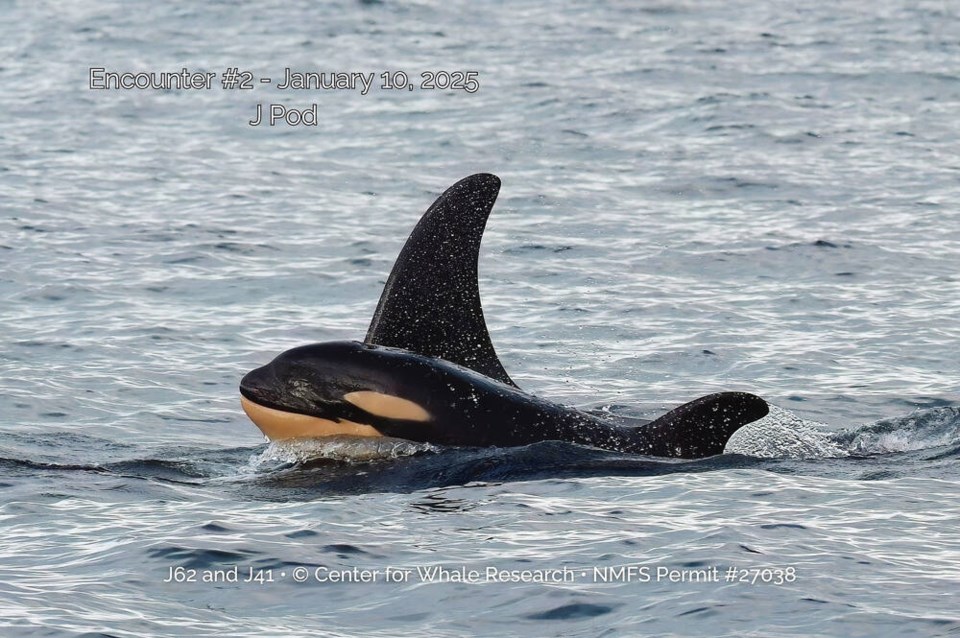Only 73 southern resident killer whales are left, but researchers believe there is a way to save the species.

For the first time, scientists worldwide have devised a plan to save the critically endangered southern resident orcas that travel in B.C. waters.
Southern resident orcas, also called killer whales, live in the Pacific Ocean off the coasts of B.C., Washington, Oregon and California, where they once thrived.
Now there are only 73 southern residents left.
A report published Monday makes 26 recommendations for governments on both sides of the Canada-U.S. border, including tougher restrictions on toxic chemicals that are harming the orcas, mainly by killing the salmon they depend on for food.
The report comes after an independent science panel of 31 experts — including researchers from Simon Fraser University, the U.S.-based Center for Whale Research, and the David Suzuki Foundation, among others — gathered in Vancouver in March to discuss the species’ conservation and recovery.
A report last year from the B.C. conservation group Raincoast and a team of international scientists found that time is running out for the southern resident killer whales as they face increased threats, such as habitat degradation through underwater noise, high concentrations of industrial chemicals and declining quality and quantity of Chinook salmon. The study’s worst-case scenario predicted they could be extinct within 40 years.
Tanya Brown, an assistant professor of marine ecotoxicology at SFU and co-author of Monday’s report, said losing the southern resident orca would be a devastating loss.
“They are apex predators in our marine ecosystem on this coast,” she said. “Once you lose a species, then everything becomes vulnerable.”
The new report recommends that governments eliminate all chemicals that accumulate in southern resident killer whale food chains by accelerating the phaseout of legacy chemicals like PCBs and PBDEs.
It also recommends strengthening regulations on emerging contaminants such as 6 PPD-quinone and PFAS, per-and poly-fluoroalkyl substances, which are used in everything from waterproof clothing to non-stick cookware.
PCBs, which were once heavily used in industrial products, were banned in Canada in the 1970s because of environmental and health risks. Although they are no longer produced, they still exist in older equipment and materials.
Brown said the deadline for eliminating existing PCBs was supposed to be the end of this year, but was recently extended to 2029.
“So we keep seeing more extensions of a contaminant that was essentially banned in the 1970s,” said Brown, also a former research scientist with Fisheries and Oceans Canada.
Emerging contaminants such as 6PPD-quinone — used on vehicle tires to prevent breakdown — are “extremely toxic,” especially for Coho salmon, said Brown.
“Every time it rains, you have these tire particles that have accumulated on the road, and then that’s all being washed off, ” said Brown. “So you get these toxic pulses in the freshwater environment.”
Brown added that 6PPD still isn’t regulated despite pressure on the government to regulate and eliminate it from the marketplace.
Other key recommendations in the report include protecting early runs of Chinook salmon that return to the Fraser River in the spring and early summer and establishing abundance thresholds that would trigger fishery closures in seasons of low returns.
Recognizing the value of wild salmon as prey, the use of hatchery salmon should ensure production aligns with the southern residents’ prey preferences, such as Chinook salmon, and prioritize production for the orcas over fisheries needs, the report says.
It also includes measures to address noise. Previous research by the University of Washington found the Salish Sea is too noisy for the orcas to hunt successfully.
Underwater noise from vessels is affecting every step in the hunting behaviour of the orcas, including finding, pursuing and capturing prey, the researchers said.
The panel recommends that governments finalize and implement vessel noise reduction targets that are biologically relevant to the southern residents, expand ship slowdowns to 11 knots while expanding slowdown zones and set mandatory noise output standards for large commercial vessels.
The panel recommends phasing out the controversial Southern Gulf Islands anchorages to “eliminate avoidable noise from bulk carriers and improve port arrival management practices.”